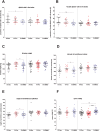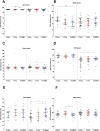Direct but no transgenerational effects of decitabine and vorinostat on male fertility
- PMID: 25692788
- PMCID: PMC4334483
- DOI: 10.1371/journal.pone.0117839
Direct but no transgenerational effects of decitabine and vorinostat on male fertility
Abstract
Establishment and maintenance of the correct epigenetic code is essential for a plethora of physiological pathways and disturbed epigenetic patterns can provoke severe consequences, e.g. tumour formation. In recent years, epigenetic drugs altering the epigenome of tumours actively have been developed for anti-cancer therapies. However, such drugs could potentially also affect other physiological pathways and systems in which intact epigenetic patterns are essential. Amongst those, male fertility is one of the most prominent. Consequently, we addressed possible direct effects of two epigenetic drugs, decitabine and vorinostat, on both, the male germ line and fertility. In addition, we checked for putative transgenerational epigenetic effects on the germ line of subsequent generations (F1-F3). Parental adult male C57Bl/6 mice were treated with either decitabine or vorinostat and analysed as well as three subsequent untreated generations derived from these males. Treatment directly affected several reproductive parameters as testis (decitabine & vorinostat) and epididymis weight, size of accessory sex glands (vorinostat), the height of the seminiferous epithelium and sperm concentration and morphology (decitabine). Furthermore, after decitabine administration, DNA methylation of a number of loci was altered in sperm. However, when analysing fertility of treated mice (fertilisation, litter size and sex ratio), no major effect of the selected epigenetic drugs on male fertility was detected. In subsequent generations (F1-F3 generations) only subtle changes on reproductive organs, sperm parameters and DNA methylation but no overall effect on fertility was observed. Consequently, in mice, decitabine and vorinostat neither affected male fertility per se nor caused marked transgenerational effects. We therefore suggest that both drugs do not induce major adverse effects-in terms of male fertility and transgenerational epigenetic inheritance-when used in anti-cancer-therapies.
Conflict of interest statement
Figures








Similar articles
-
Transgenerational impaired male fertility with an Igf2 epigenetic defect in the rat are induced by the endocrine disruptor p,p'-DDE.Hum Reprod. 2014 Nov;29(11):2512-21. doi: 10.1093/humrep/deu208. Epub 2014 Sep 3. Hum Reprod. 2014. PMID: 25187598
-
Seminiferous cord formation and germ-cell programming: epigenetic transgenerational actions of endocrine disruptors.Ann N Y Acad Sci. 2005 Dec;1061:18-32. doi: 10.1196/annals.1336.004. Ann N Y Acad Sci. 2005. PMID: 16467254 Free PMC article. Review.
-
A therapeutic trial of decitabine and vorinostat in combination with chemotherapy for relapsed/refractory acute lymphoblastic leukemia.Am J Hematol. 2014 Sep;89(9):889-95. doi: 10.1002/ajh.23778. Epub 2014 Jun 27. Am J Hematol. 2014. PMID: 24891274 Free PMC article. Clinical Trial.
-
Exposure to endocrine disruptor induces transgenerational epigenetic deregulation of microRNAs in primordial germ cells.PLoS One. 2015 Apr 21;10(4):e0124296. doi: 10.1371/journal.pone.0124296. eCollection 2015. PLoS One. 2015. PMID: 25897752 Free PMC article.
-
The effects of diabetes on male fertility and epigenetic regulation during spermatogenesis.Asian J Androl. 2015 Nov-Dec;17(6):948-53. doi: 10.4103/1008-682X.150844. Asian J Androl. 2015. PMID: 25814158 Free PMC article. Review.
Cited by
-
Out of sight, out of mind? Germ cells and the potential impacts of epigenomic drugs.F1000Res. 2018 Dec 21;7:F1000 Faculty Rev-1967. doi: 10.12688/f1000research.15935.1. eCollection 2018. F1000Res. 2018. PMID: 30613387 Free PMC article. Review.
-
Differential DNA methylation at conserved non-genic elements and evidence for transgenerational inheritance following developmental exposure to mono(2-ethylhexyl) phthalate and 5-azacytidine in zebrafish.Epigenetics Chromatin. 2017 Apr 12;10:20. doi: 10.1186/s13072-017-0126-4. eCollection 2017. Epigenetics Chromatin. 2017. PMID: 28413451 Free PMC article.
-
Paternal age affects offspring via an epigenetic mechanism involving REST/NRSF.EMBO Rep. 2021 Feb 3;22(2):e51524. doi: 10.15252/embr.202051524. Epub 2021 Jan 5. EMBO Rep. 2021. PMID: 33399271 Free PMC article.
-
Paradoxical whole genome DNA methylation dynamics of 5'aza-deoxycytidine in chronic low-dose exposure in mice.Epigenetics. 2021 Jan-Feb;16(2):209-227. doi: 10.1080/15592294.2020.1790951. Epub 2020 Jul 11. Epigenetics. 2021. PMID: 32619143 Free PMC article.
-
Unfolding the complexity of epigenetics in male reproductive aging: a review of therapeutic implications.Mol Biol Rep. 2024 Aug 1;51(1):881. doi: 10.1007/s11033-024-09823-9. Mol Biol Rep. 2024. PMID: 39085654 Review.
References
-
- Qiu J (2006) Epigenetics: unfinished symphony. Nature 441: 143–145. - PubMed
Publication types
MeSH terms
Substances
LinkOut - more resources
Full Text Sources
Other Literature Sources
Molecular Biology Databases
Miscellaneous

